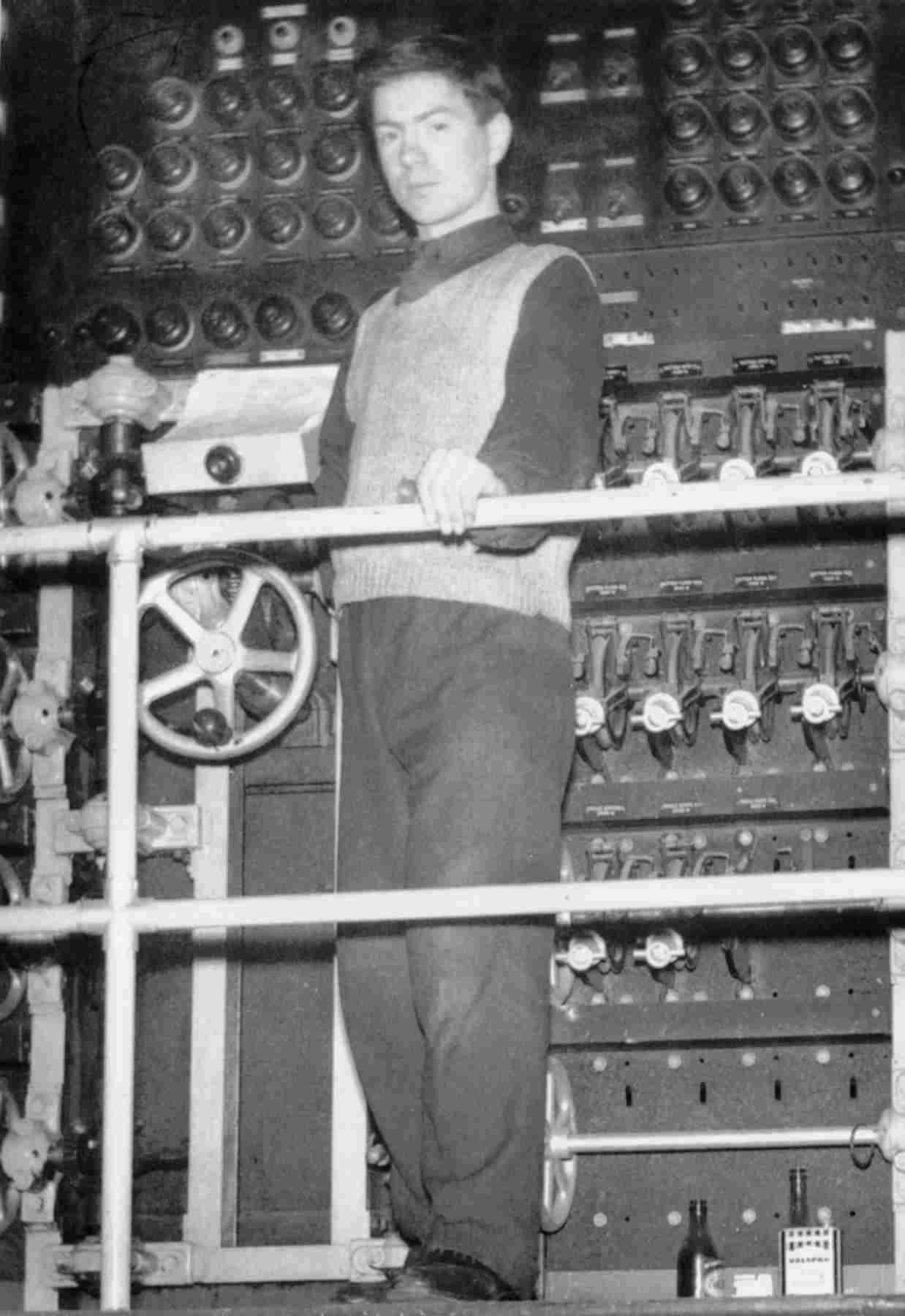
.jpg)
TIVOLI MEMORIES
By
Bill
Reid
(Please respect the copyright of
these photographs)

.jpg)
It was late Summer in 1961 that quite by accident I got myself employed at the Tivoli Theatre as Stage Lighting Operator. The Alex Findley Show was in it's last two weeks and the outgoing Lighting Operator (A New Zealand chap) showed me the ropes during that period. My first solo show starred Aly Wilson. It ran for three weeks and I was just starting to enjoy the work when the show was terminated and the theater closed for some weeks. It was quite a let-down, but the start of the end of the Tivoli as a regular Variety Theatre. It would soldier on with some high moments but eventually closed in 1966, almost three years after I had moved on.
Other shows that I worked with were, Alex Findley, Jack Milroy, Lex McLean, Johnny Victory and Clark & Murry, Calum Kennedy, Scout Show and Christmas Pantomime (Dick Whittington 1962).
I had been a regular theatergoer since first being taken to the Tivoli by my Aunt Maggie around 1946/7. I knew of most of the regular and top artists who appeared there and it was really nice to actually be working on their shows. However, while the Alex Findley Show had been packing them in over the Summer of 1961 I was soon made aware that the Ally Wilson Show that followed had entered the autumn season and audiences, especially during the week were very thin. We were handing out more free tickets than paying audiences. Likewise, the 1962/3 winter was on it's way and turned out to be the coldest and one of the longest winters since 1947. I recall walking over pavements of deep frozen snow for weeks and often had to walk into work as it was impossible to cycle or take the bus into town. When this miserable winter ended, one of the cartoons in the newspaper I always remember is of a woman pushing her child in it's pram, with the child screaming in terror, and the mother explaining ''It's all right dear, it's only the Sun'. Which really says everything about that winter.
The stage and orchestra pit taken from the Stalls. The theatre had been closed for some weeks and everything had been washed, cleaned and polished ready for the opening of the Jack Milroy Show in 1962.
.jpg)
Jack kindly posed for this photograph, which I treasure very much. Jack never put on airs and graces and would talk to everyone on the same level. He would quite suddenly drop in the room and chat over a cup of tea. If an artist add-libbed a joke during a sketch that raised a laugh Jack would tell them to keep it in for the rest of the week. Many supporting artists were told off or even sacked for upstaging the star of the show. But Jack thoroughly encouraged them. On the right is an autographed photo I got from Jack at the stage door around 1952/3. Around the time of Jack and Mary's wedding.Sadly, Jack died in February 2001, aged 80. He was presented an O.B.E. by the Queen for services to entertainment. Mary had been quite a successful singer in her own right. The greeting of ''Hello R'ere'' and ''Hello China'' will forever be Jack's catch words.
Most of you outside of Scotland will probably have never heard of Jack Milroy but to me he was a star as big as Bob Hope or any other well known International star, albeit within Scotland. Stars who remained in the home stage seldom made it to U.K. National or International status, but that made them no less a star. You can go to a very nice web site dedicated to Jack at: http://www.paviliontheatre.co.uk/loganmilroy/milroy/index_milroy.htm and learn more about this great comedian. This web site, which is run by the manager of the Pavilion Theatre in Glasgow also includes a dedication to the late Jimmy Logan.
Glen Michael was feed to Jack for many years. From Devon, Glen would take a lot of stick being in virtually a 100% Scottish Show and this was built into the sketches themselves, where he would stumble over Scottish expressions. It gained Glen a lot of respect and he remained with Jack to the very end. Today Glen still broadcasts on Scottish radio.
An autographed picture, gained at the stage door at the same time as the one of Jack and Mary (1952/3) They appeared in the first great Summer Season of Jack Milroy shows and were very popular. I passed them in George Street one evening and Nina mistook me for someone's child that she must have been staying with. I didn't have the heart to tell her and just enjoyed meeting them and talking with them for a moment or two.
Another autographed photo of that time around 1952/3. Dave and Joe O' Duffy, Irish comedians of a high caliber, who had them rolling in the isles.This and the following year's Summer Season, of Jack Milroy Shows were the most popular and continually booked up shows in the Tivoli's history, with que's really going 'right around the block'. The atmosphere at the Tivoli was never the same after these shows finished and no matter how good, whoever followed them never stood a chance. I attended the last shows of both these seasons and have never seen anything like them since and all the artists who appeared with Jack are still remembered today by myself and theater going Aberdonians of that period. The spell really wasn't broken until Scottish comedian, Johnny Beattie came along, but in spite of that and the fact that other Summer Shows had successful seasons, none ever ran the length of time that Jack's did. Alex Findley and Calum Kennedy continued to pull them in until TV kept audiences at home on cold winter days.
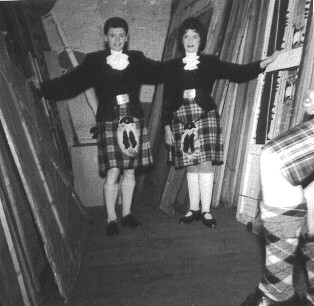
Ronnie Parnell & Marie Ashton. The last time I met Ron was at the Pavilion, Llandudno in 1998, where Ron was producing shows and still dancing in great style. The Scott Boys appeared in the summer show of 1962. Two of the group went on to appear on TV's New faces and made a number of records with a female singer. This photo is a publicity picture which they kindly autographed for me.
.jpg)
Alan Beal was a very fine clarinetist and all round musician who also enjoyed joining in
the spirit of the show. Alan came from London but enjoyed dressing up for the part.
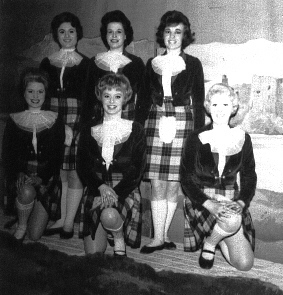
No variety show was complete without its row of pretty Chorus Girls.
These were regular dancers from the Moxon Dancing Group.
Artur Spinks (Accordionist). Arthur went on to become one of Scotlands well-known accordionists.
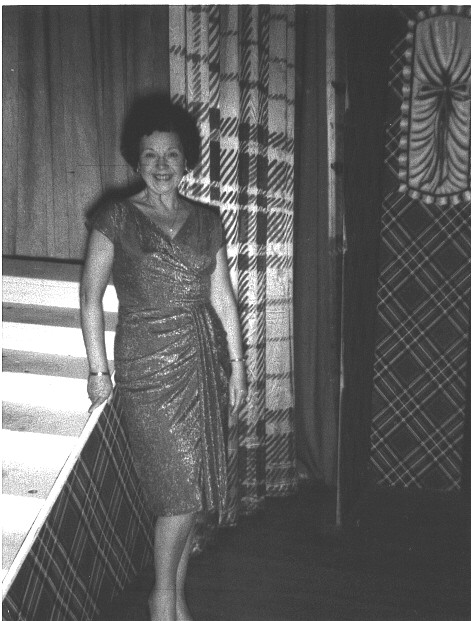
While Mae Clark (Of Clarke & Murry fame) was of the older school, Joe Gordon was just starting in his stride with stage and TV appearances and hit records with his 'Folk Four' group. Joe was just visiting the theatre that day but kindly posed for this photograph. The photo of Mae and others that I took at the time were enlarged and displayed at the front of the theatre during the Clark and Murry Summer season, which was a great thrill for me. However, Mae kept all the negatives and the print here is all I have of that set.

Faith Roberts was a popular singer while Rosa Duval was more light opera.
They appeared in the Summer show of 1962.
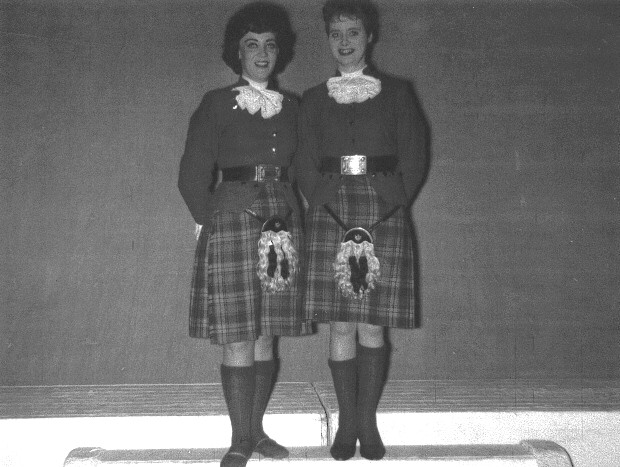
Faith Roberts and Rosa Duval----------------------------------------Betty Melville
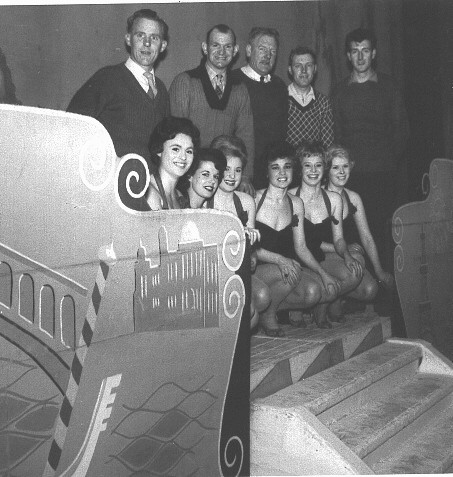
Chorus and Stage Hands 1962
Alan Beal joins in the fun of posing for a group shot
Everyone joined in the fun
Many of the stagehands were part timers and had full time jobs to maintain and worked long hours, as did the Lime Operators. This snap was taken from the Stage Lighting platform, while they enjoyed a food break amongst the scenery. Usually timed while an act performed front of stage and didn't require any scenery or curtain changes for a few minutes. And below, a stagehand grabs a bit of shut eye during a quiet moment.

Tommy Wright hailed from the Manchester area and was a very nice singer. Tommy had a character role in Coronation Street in the 70's but the part seems to have been given to someone else after a while. On the right is Edna Percival, singer and dancer, whom Tommy married while appearing at the Tivoli.
Tommy Wright and myself
TivoliAbdn1963.jpg)
Local 'character' comedian Roland Smith. Taken in his dressing room and on the right against a stage backdrop in 1962. Roland
carried on the great traditions of that other great Aberdeen comedian, Harry Gordon.
Autographed photo of Roland Roy & Jackie Toaduff. Dancers and choreographers who
often produced shows too. Jackie's fame was said to be that he once danced with Princess Margaret.
Maurice Hartnell was a local drummer who was part of the George Seiveright Trio
Ernie Cooper, was a great chap and we had many enjoyable chats about past shows, artists and events. Ernie stands by some of the scenery he had just freshened up during one of the long closure periods. To his right is the Tivoli's Grand Piano.
.jpg)
Left: Tivoli Manager, Andy Foley, outside the Stage Manager's Office.
Right: Stage Manager Dave Alan and his daughter. Dave followed his brother,
Bert, whom in his time managed during some of the Tivoli's greatest moments.
Dave retired on closure having seen the Tivoli's lowest moments.The Tivoli became a Bingo club until the late 90's and today stands empty, but protected as a listed building. Attempts have been made to reopen it as a theatre but never come to anything. Over the last few years it has been opened to the public during the once a year 'Public Building' days, when guided tours of such buildings are in operation. Outwardly the building is looking rather forlorn and will only ever receive a fresh coat of paint should it reopen as an entertainment venue. Perhaps it will glow with bright lights and laughter again, stranger things have happened!
What was it like actually working at the Tivoli! Like any job it had it's up's and down's, but on the main it was a happy place where serious work had to be carried out to quite strict time scales. On a Monday you started at 8.30am and because the previous week's show had to be dissolved and everything prepared for the new show, it was a long day, not getting finished until around 11pm and two performances later, with just a break between Midday and 5.30pm. Monday to Saturday. The Union did gain us a 'day off'' but you still had to go in at 8.30 in the morning until midday.
In the case of certain props, that search started the week before. A football was required for one show and you couldn't go out and buy just any football! a trip to Aberdeen's Pittodrie Football ground and a request for a lone of a football is what it took. Of course, Pittodrie got a plug during the show and in the programmes and the local team 'The Dons' received a cheer from the audience, so everyone was happy. Similar dealings were agreed between numerous shops and businesses in the city.Some goods, and especially any electrical replacement for the theatre would come up from England by train and had to be collected at the goods station. I once picked up a couple of 1000 watt lamps that came from A. E. C. in Rugby but for some reason had reached Aberdeen station via Banff! When I asked why, the goods depot worker said, ''Because that's the way it is''. A lesson for my future employment, perhaps!!!
Large instruments such as a Hammond Organ would come by a large delivery truck with a lift. The rear stage entrance was set a good 10 feet above street level and that was quite a task to perform.
Most of the costumes and small personal props arrived by train in large wicker type laundry baskets, that would take two people to cart upstairs or drag into the dressing rooms. The stars' dressing room was on the second floor a short walk from the stage entrance, while the chorus dressing rooms were on the first floor and the remainder on third and fourth floors. As electrician it was my job to replace or repair all the dressing room and mirror lights.
Monday was busy with setting up stage, backcloths set props etc. I would watch as each artists or set piece was being rehearsed and enquire about the lighting and any cues. In most cased the star of the show, or the producer would seek me out and let me know the routine and 'cue' for a blackout. I had to discuss with the producer and set down all the lighting routines for the individual performers and the set musical pieces that always concluded the first half of the show and the Star's songs etc during their act. With comedians there would always be a 'cue' line for an instant blackout at the end of a joke or routine. This had to be precise, as too soon or too late would ruin audience reaction. Likewise I had to make a copy of my own routine so that the Lime Operators knew what was happening and which colours to use on a singer or whoever as rhythm and moods changed, and of course, the inevitable 'blackout'. There was no voice communications between us and a buzzer code existed so that when I pressed the button it gave them time to react.. The Lime boys were very experienced and many moves could be worked out as they went along. Likewise, for myself. For the first show of the week we would all work to the 'book' but once you knew the routine I could operate the lights more relaxed and time changes of colours etc more smoothly and precisely.
I found that Wednesdays were the worst days! On a Monday you would be all keyed up and eager to learn and get things right and by the second show everything would be in it's place. On a Tuesday everything ran smoothly, but come Wednesday and everyone appeared to have over relaxed and taking things a bit for granted and that was when numerous silly errors would happen. From artist to stagehand we all seemed to fall for that on a Wednesday. The rest of the week would usually go well, with mainly electrical problems having to be overcome, or replacement props for those that broke.
Rehearsals started on as Wednesday, which may have cause the 'errors, as it must be difficult to stop thinking about the news stuff you have learned and go back into the daily routine of the present show. Mornings were mainly used up resetting the stage and props and general cleaning. replacing bulbs and fuses was always ongoing. Cleaning down and resetting the lighting panel and platform was also a daily chore.
About the worst job in the building was replacing the 120 watt 'cleaner's lamp'. This single lamp hung from the center of the theatre, above the chandelier and gave out more than enough light for the cleaners. It saved on having the theatre side lights or main lights on. However, to replace the lamp I had to go right up into the rafters of the building and unscrew the mains lead from the lamp holder and untie the lamp from it's fittings and lower it to just above seat level in the Stalls and then go back down to replace the lamp and clean the shade etc, then all the way back up again to haul the lamp back up and tie it on and refit the mains leads. You needed a head for heights as you were looking down through small wooden slats directly to the seating about 80 feet below and you wouldn't want to slip into the well otherwise you would be in among the seats in a flash. However I did once hit my head on the large electric fan just above the cleaning lamp fittings and I not only saw stars for a while but the blades of the fan rang out so loud that the Stage and Theatre Manager all came out of their rooms and looked up to see if I was all right.
This happened in the middle of 1962 when the theatre was closed for some weeks, as it had been doing on an alarming scale. TV had been affecting audiences as it had with the cinemas and the theatre was only opening when a show with some pulling power could be put on for a fixed period. During this long closure most of the staff were kept on and we worked daily setting to and cleaning just about every corner of the theatre that we could get to. I know, I cleaned virtually every lamp in the building, including shades. The rows of front and side stage lighting was heavy going and I know just how heavy, as when I got Dave to lift one section of the front lights to get to some fittings, he accidentally dripped it and I went around with a black thumb nail for weeks afterwards. Charlie, the painter busied himself washing and painting all the walls and ceilings. I did help him at one stage to wash out the Lime Room. Dave worked on fitting a new electric fan into the Stall's Bar. Not as easy as it sounded as he had to punch a hole some inches deep in the stone and plaster to reach the other side and it was a long dusty job.
Another interesting experience for me was that during this period I did a bit of overtime, acting as caretaker on a Saturday morning until late afternoon when the regular fireman would take over. The Tivoli was over 80 years old by then and a well established building, even to having it's own 'ghost'! Which, of course, I didn't believe in. However, when you are suddenly left alone in a massive building such as this, you soon become aware of all sorts of noises. Most are just aged timbers creaking. The ropes and heavy backcloths high in the Fly's also had their own sounds. After a while you would swear you heard something or someone moving in the wooden walkways around the Fly's.
I always brought along the very first portable radio I ever had, which used an old fashioned ear piece and also my mains reel-reel tape recorder and played lots of music to fill the emptiness. Other times I would tinkle on the Grand Piano or partly raise the safety curtain and switch on a few well placed stage lights, the amplifier and microphone and sing, or play my harmonica for a while, pretending there was an audience out there. The sound doesn't half travel and I am sure it was heard out in the street too. The microphone had been used by numerous well known people of the Scottish and British Stage.
However, at the end of it the theatre looked a treat. You almost had to close your eyes when the full lighting was turned up. The Upper Gallery (The 'Gods'), the Circle and the Stalls, the two 'Boxes' each side and the alcoves with statues and backlighting all looked as they must have done when brand new. A photograph of this was published in the booklet ''Aberdeen Tivoli'' by J. H. Littlejohn and I feel quite proud every time I see it and knowing that that experience has been recorded for history.
One of the busiest times I experienced at the theatre was during the annual 'Boy Scouts' Shows. These eager beavers used just about every prop invented for the theatre, all in one show! To get the show ready for the Monday opening we stayed after the second house on the Saturday night and worked right through Sunday. While we drank plenty of tea I recall only having one food break and that was on the Sunday afternoon when they held a Buffet in the old Great North Of Scotland Buildings alongside the Station in Guild Street. Every act or scene had the stage filled with scenery and props off all sorts and there was dozens of actors and part players milling about the theatre and stage throughout the whole week.
One set was of Prince Charlie during his flight after Culloden and the usual rendering of 'Over The Sea To Skye', in which there was a storm, where they used a real maritime maroon for the explosion. This was set off inside a dustbin (Litter Can) with a sack cloth over the top. I had to set this off at a given cue, but while every other person and stage hand had cleared out by the time it was due to go off, I of course had to stay in position, up on the lighting stage and set the Maroon off. Even while being prepared for it the shock would virtually lift me off my feet and by the end of the week and 14 performances later I was completely shattered by shell shock and long hours of none-stop work. I wonder how Health & Safety would deal with this today!!! The sack cloth disappeared a number of times, stuck somewhere in the rafters, no doubt. It may still be there yet! If anything, these 'would be' actors were certainly full of enthusiasm, but I doubt if that would have lasted so long, or remained so keen, if they had to do that every week of their working lives. Once a year, is more than enough.
The Scottish artist who did everything he could to keep the theater open was Calum Kennedy ''The Voice Of The Highlands''. Calum was at the height of his singing profession and had a fantastic team of artists that traveled with him. There was no doubting that he could pull in the crowds. You couldn't go wrong with names such as Will Starr, Accordionist, Ken Swann and Magee,
I really enjoyed working alongside Calum and his artists. they were all thoroughly professional and keen to make every show sparkle. Calum was very approachable and took interest in the Tivoli staff. It was also magical to operate the lights for such a show and when Calum was on stage for his main performance, he had the audience in the palm of his hand from the opening beats of music and would go on and on singing great Scottish songs one after the other. I loved playing the lights to his singing and music and sang and danced up on the lighting platform and was able to watch both Calum and the Audience's reactions throughout the performance. Calum also specialized in Gaidhlig songs and I was so taken by these that in the mid 70's I took it upon myself to try and learn the language. I never did become proficient but I still remember enough to make sense of anything I read in Gaidhlig.
In spite of the great shows and drawing full houses at the weekend, the weekdays remained very quiet and the Tivoli continued to close for a number of weeks between further shows. In fact more people turned up for yet another 'final show' than turned up for everyday shows.
The Tivoli seemed to do best when it presented local artists and Scottish entertainment or brought in a really big name. I shall always remember the local shows such as the 1962 'Your Ain Folk', with Robbie Shepherd, Bobby Watson, The Curly MacKay Band and the George Sievwright Trio and other local artists. They were pure entertainment and lots of fun and attracted large audiences from all around Aberdeenshire. Perhaps if they presented more of these types of shows and possibly with just one performance an evening, the Tivoli may have kept going, or at least for a lot longer than it did.
Autographed photoAlex Findley was well named 'The Gentleman of Variety'. He was the first star I ever saw at the Tivoli as a child and he remained a great favourite and it was a great pleasure to work on his show and get to meet him. During his October 1962 show, which included, Bond Rowell and Helen Norman, his long time 'feeds', along with The Scott Boys, George Cormack & Irene Sharp, Ronnie Parnell & Marie Ashton, Danny Drysden (Street) and Roland Roy & Jackie Toaduff. In J. H. Littleton's book he mentions that Roy & Jackie joined the show for the last two weeks of the production. This was due to an incident that included myself as Stage Lighting Operator! The original producer was --- ---, who shall remain nameless, but as I have explained, on A Monday it was my duty to watch rehearsals and get to know the lighting plots and cues. On this particular Monday, of the very first day of the show, the producer totally ignored me and when I eventually insisted he said he would see me at midday. We were normally out of the theatre from around midday until 5pm. I actually hung around the theatre until 2pm, two hours past free time, and in my own time, but he never appeared.
5pm came around and I still didn't have any information, nor could I give the Lime boys any cues etc. However, I hurridly caught each artist as they turned up at the theatre and got their views and what numbers they would be performing and going by the tempo of the tunes and performance I wrote down a basic lighting routine. I never saw or heard from the producer right up to and during the show. The Lime boys were livid, but did their best and waited for my buzzer codes and tried to stay in step with the performance. Such was their experience they did very well, as I did, until during the first half finale, there was a dance routine with the producer, who was also a dancer, and the chorus and I found that I couldn't catch lighting changes or make colour changes as the mood and pace was changing too quickly.
At One point in the performance I was also getting pretty annoyed and at a certain point the producer wanted a certain lighting mood and I had no idea it was coming or what it should be and from the stage I heard quite clearly the producer, shout Useless B---d'', and I could see the reaction from the Musical Director, Johnny Douglas, and the band, in the orchestra pit, that they too heard it clearly, as possibly the front row did too, at which point I raised all the stage lights to maximum brilliance and left them there for the remainder of the act.I was expecting trouble, and sure enough the producer roared off the stage and came straight for me, but thankfully Tommy Wright and some stage hands cooled the situation and we simply exchanged words, with him at stage level and I on the control panel platform. The remainder of the show went all right as we all understood what was required. However, next morning I had to report to Theatre Manager, Andy Folly, to explain the situation. I explained things as truthfully as possible and half expected to loose my job, but the outcome was, that I remained with the show while the 'producer' was replaced by Roland Roy and Jackie Toaduff, who went on to produce great shows. They were very professional.
My disappointment in the outgoing 'producer' was that I also knew of him and had seen him in numerous shows over the years and while he always had an air of arrogance about him, his shows and performances were very entertaining. I got no joy from this situation and even today just feel sad that it turned out that way. How or why he expected me, or the Lime Boys to work to 'unwritten' script, is a mystery!
The Alex Findley show was great fun. Another incidence I will always remember with fondness was that Alex Findley had recently toured Australia and he had some 8mm cine films arrive and wanted to view. He asked around the theatre for anyone with a projector and as luck had it, that was my hobby. WE arranged to bring the projector (an old Specto) and screen and set it up in the Star Dressing room, one afternoon and Alex, his wife and others bunched into the room and we ran the reels of film. As Alex's show in Australia took place during Christmas and along with all the new scenes in the film it was the first time that I had ever seen Christmas being celebrated in the heat of Summer! It was quite fascinating and I shall always appreciate having played my part in making that gathering possible.
The Calum Kenney Show followed in October 1962, with his regular touring team of Scottish artists, that was assured success but also with him was an Irish comedian, Sammy Short, who was a real live wire. Sammy was as funny off stage as he was on and his energy and sense of fun carried every sketch to belly-laugh level.
As mentioned above, cine photography was my hobby, but I was always reluctant to take film in the theatre. Film was expensive and very slow in those days and I couldn't be sure that I would even get an image on the film. However, I took a few shots from the lighting platform and then during a longish sketch when all stage lights were up, I went down to stage level and grabbed a few shots from that angle. I didn't get much time to use the camera. However, between the two performances I managed to take 3-4 minutes of film during the same scenes. One or two artists objected as they thought I may be trying to make some money from the film, but I assured them that it was purely for my own use.
I eagerly waited the films return from processing and was very pleased at the results. After 43 years it has become quite a historical piece of film. The scenes include Calum, Will Starr, Ken Swann & Magee, singer Rae Gordon, dancer Vi Day and comedian Sammy Short. Part of a sketch which includes a 'Bucket' and a musical sketch with Calum and the chorus. The film ends with clips of Calum doing his own act.I conclude with a couple of photos of the Tivoli as is today...............
The Tivoli in April 2004. Could it ring to music and laughter again!!!
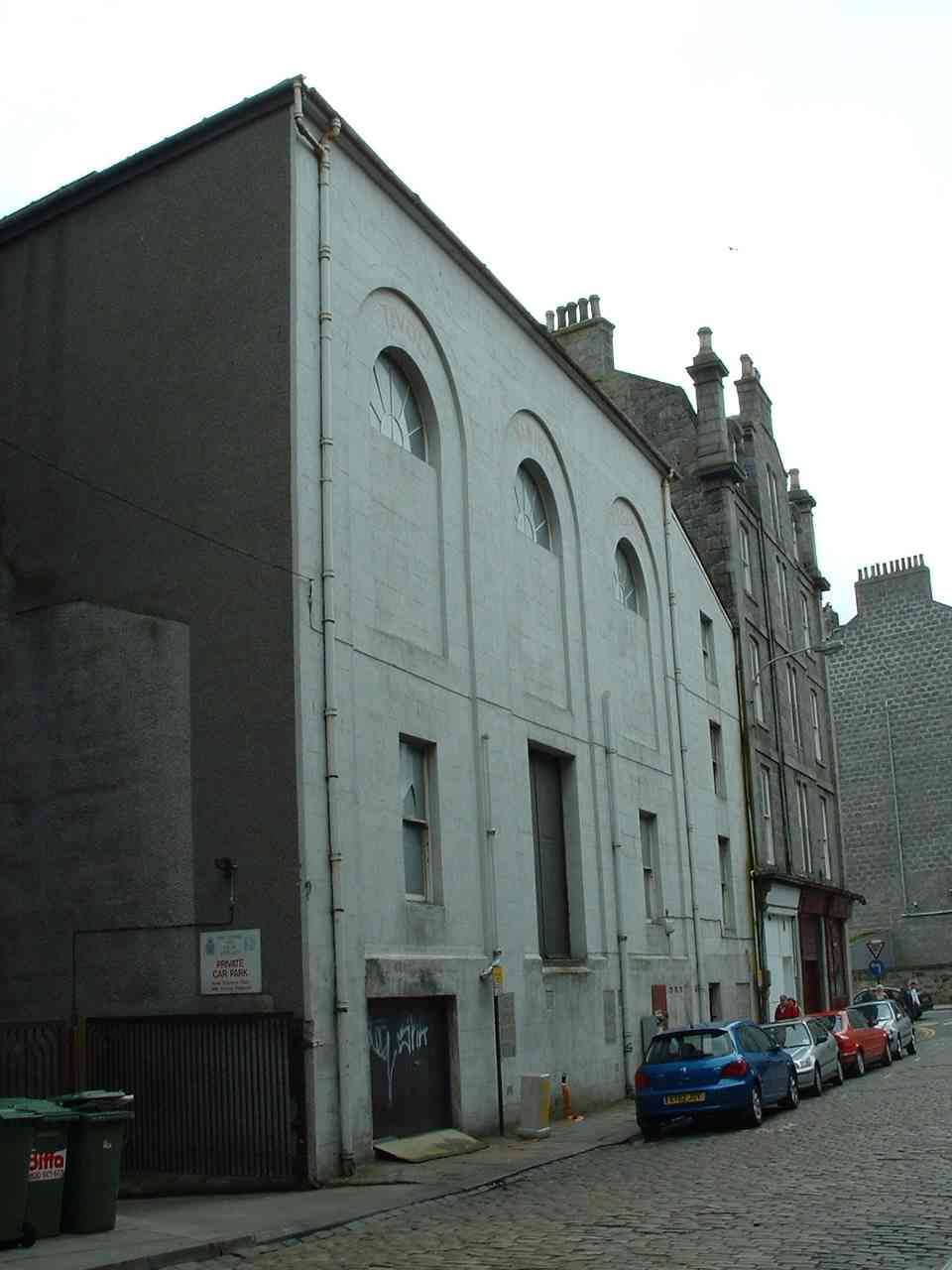
Backstage entrance. Shows the height of the rear stage doors approx ten feet above street level. The three arched winds allows light into the Fly's area. The three windows on the far left are the star's dressing rooms. The double doors let into the electrics room, where there was a Mercury ac/dc Transformer, as used by many theatres and cinemas, prior to solid state transformers. When I joined the railway I was surprised to find that the AC overhead electric locomotives used these delicate transformers, where noise and vibration and speeds up to 100 mph didn't appear trouble them. Perhaps they weren''t as delicate as they looked! There was one at the Majestic cinema. They gave off a very eerie blue light that arced and crackled and were used in the old Frankenstein films, along with other electrical apparatus, to good effect.End note: I came across a web site dedicated to Scottish Theatres and Cinemas and which includes some photographs of the interior of the Tivoli as it is today. The photos were taken by a member of the public who attended one of the annual 'Open Public Buildings Days' when organised tours are given of buildings usually closed to the public. The photographs are not very sharp, no doubt due to the available light and a handheld camera but they give a fascinating insight to the present day situation with the theatre. While I enjoyed seeing all the pictures, one in particular, far right , on the second last line, is of interest to me as it shows the Stage Lighting Control Panel still in situ, which I am sure you will recognise from the first two pictures of this web site, of myself on the platform. I feared that it may have been dismantled. However, it controlled both the stage and the 'house' lights and probably is still required for present use and, maybe even it's future use, albeit there are more modern electronic and digital systems today that could do the job more easily and economically, but the control panel is every bit as historic as the theatre and deserves to continue playing it's part.
Another picture that tells a story is the interior shot far right on the top line. It shows the newer 'Lime Box' at the back of the 'Gods' (Gallery). This was built in the 40's and I remember it being in different stages of construction. However, you can see two 'windows' cut out on the proscenium, a little apart from each other ... this was the original 'lime Box' if you could call it that. One of the Lime workers, the late John Lynch, lodged with us during the 50's and he told us stories about working in the 'Limes' fascinating as you virtually had to lye down to operate them and the side-to-side movement was so narrow that the carbon arc would hit the sides and restrict how far you could point or spread the light. Being carbon arc usage the fumes too were quite bad at times. I had a look inside the 'room' during one of our closure periods and it was really no more than the space between the gallery floor and the proscenium roof. As John was over 6 foot tall it must have been quite a squeeze. I can recall watching what was going on there during a show and when you consider they had to rotate coloured wheels and add colour filters etc, they must have had their work well cut out for them. The new box was more like a small projection room at a cinema.
The photos of the 'Fly's' area also brought back some memories. When all the backcloths were hanging from their fittings, you got the smell of heavy rope and he thick wooden railings which made if feel as if you were on a ship. It was the darkness and creaking of the ropes and woodwork, during the time when I was acting as caretaker and on my own, you could easily image that there was indeed a theatre ghost! This area was never as bright as it is in these photographs.
It is good to know that the City Council still prefer to have the building reopened as a place of live entertainment and it would be fantastic if this comes about and the Tivoli is given a well-deserved refurbication.
The web pages mentioned are at:
http://www.chem.gla.ac.uk/~gbarr/cinemas/scotland/aberdeen/tivoli/
If you have the time, and the interest, by going back to their main page you will find a fascinating insight to past and present Scottish Theatres and cinemas, of which the Tivoli is part.
Any additional information would be most welcome. reidcrcwdr@aol.com
==================================